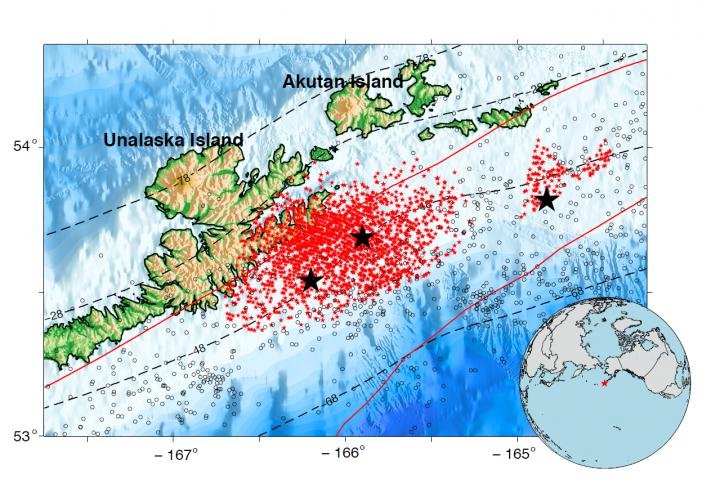Slow earthquakes occur continuously in the Alaska-Aleutian subduction zone

Image shows tremor sources and low frequency earthquake distribution in the study region and historic large earthquakes in the Alaska-Aleutian subduction zone. Each red star represents the location of 1 min tremor signal determined by the beam back projection method, and the black stars show three visually detected low frequency earthquakes located using arrival times of body waves. Credit: Ghosh lab, UC Riverside
Seismologists at the University of California, Riverside studying earthquakes in the seismically and volcanically active Alaska-Aleutian subduction zone have found that “slow earthquakes” are occurring continuously, and could encourage damaging earthquakes.
Slow earthquakes are quiet, can be as large as magnitude 7, and last days to years. Taking place mainly at the boundary between tectonic plates, they happen so slowly that people don't feel them. A large slow earthquake is typically associated with abundant seismic tremor–a continuous weak seismic chatter–and low frequency (small and repeating) earthquakes.
“In the Alaska-Aleutian subduction zone, we found seismic tremor, and visually identified three low frequency earthquakes,” said Abhijit Ghosh, an assistant professor of Earth sciences, who led the research published recently in Geophysical Research Letters. “Using them as templates, we detected nearly 1,300 additional low frequency earthquakes. Slow earthquakes may play an important role in the earthquake cycles in this subduction zone.”
The Alaska-Aleutian subduction zone, which stretches from the Gulf of Alaska to the Kamchatka Peninsula in the Russian Far East, is one of the most active plate boundaries in the world. It is 3800 km long and forms the plate boundary between the Pacific and North American plates. In the last 80 years, four massive earthquakes (greater than magnitude 8) have occurred here.
Ghosh explained that tectonic tremor–which causes a weak vibration of the ground–and low frequency earthquakes are poorly studied in the Alaska-Aleutian subduction zone due to limited data availability, difficult logistics, and rugged terrain.
But using two months of high-quality continuous seismic data recorded from early July-September 2012 at 11 stations in the Akutan Island, Ghosh and his graduate student, Bo Li, detected near-continuous tremor activity with an average of 1.3?hours of tectonic tremor per day using a “beam back projection” method–an innovative array-based method Ghosh developed to automatically detect and locate seismic tremor. Using the seismic arrays the method continuously scans the subsurface for any seismic activity. Just like a radar antenna, it determines from which direction the seismic signal originates and uses that information to locate it. Practically, it can track slow earthquakes minute-by-minute.
Ghosh and Li found that tremor sources were clustered in two patches with a nearly 25?km gap in between them, possibly indicating that frictional properties determining earthquake activities change laterally along this area. Ghosh explained that this gap impacts the region's overall stress pattern and can affect earthquake activity nearby.
“In addition, slow earthquakes seem to have 'sweet spots' along the subduction fault that produces majority of the tremor activity,” he said. “We found that the western patch has a larger depth range and shows higher tremor source propagation velocities. More frequent tremor events and low frequency earthquakes in the western patch may be a result of higher fluid activity in the region and indicate a higher seismic slip rate than the eastern region.”
Ghosh, Li, and their collaborators in multiple institutions in the United States have taken the next step by installing three additional seismic arrays in a nearby island to simultaneously image the subduction fault and volcanic system.
“This ambitious experiment will provide new insights into the seismic activity and subduction processes in this region,” Ghosh said.
###
The study was supported by grants to Ghosh from the National Science Foundation-Division of Earth Sciences, EarthScope, the United States Geological Survey, and the Alaska Volcano Observatory.
The University of California, Riverside is a doctoral research university, a living laboratory for groundbreaking exploration of issues critical to Inland Southern California, the state and communities around the world. Reflecting California's diverse culture, UCR's enrollment is now nearly 23,000 students. The campus opened a medical school in 2013 and has reached the heart of the Coachella Valley by way of the UCR Palm Desert Center. The campus has an annual statewide economic impact of more than $1 billion.
Media Contact
All latest news from the category: Earth Sciences
Earth Sciences (also referred to as Geosciences), which deals with basic issues surrounding our planet, plays a vital role in the area of energy and raw materials supply.
Earth Sciences comprises subjects such as geology, geography, geological informatics, paleontology, mineralogy, petrography, crystallography, geophysics, geodesy, glaciology, cartography, photogrammetry, meteorology and seismology, early-warning systems, earthquake research and polar research.
Newest articles

NASA: Mystery of life’s handedness deepens
The mystery of why life uses molecules with specific orientations has deepened with a NASA-funded discovery that RNA — a key molecule thought to have potentially held the instructions for…

What are the effects of historic lithium mining on water quality?
Study reveals low levels of common contaminants but high levels of other elements in waters associated with an abandoned lithium mine. Lithium ore and mining waste from a historic lithium…

Quantum-inspired design boosts efficiency of heat-to-electricity conversion
Rice engineers take unconventional route to improving thermophotovoltaic systems. Researchers at Rice University have found a new way to improve a key element of thermophotovoltaic (TPV) systems, which convert heat…



